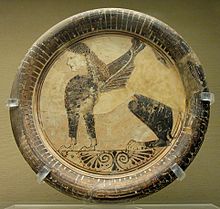Ναύκρατις | |
 Seated sphinx plate, Eastern Greek Orientalizing, 6th century BC, from Naukratis | |
| Location | Beheira Governorate, Egypt |
|---|---|
| Region | Lower Egypt |
| Coordinates | 30°54′04″N 30°35′33″E / 30.90111°N 30.59250°E |
| Type | Settlement |
| History | |
| Associated with | Athenaeus |
Naucratis or Naukratis (Ancient Greek: Ναύκρατις, "Naval Command";[1] Egyptian: njwt-kꜣrṯ, nskꜣrṯ, pr-mryt,[2] Coptic: Ⲡⲓⲉⲙⲣⲱ Piemro[citation needed]) was a city and trading-post in ancient Egypt, located on the Canopic (western-most) branch of the Nile river, south-east of the Mediterranean sea and the city of Alexandria. Naucratis was the first and, for much of its early history, the only permanent Greek settlement in Egypt, serving as a symbiotic nexus for the interchange of Greek and Egyptian art and culture.
The modern villages of Kom Gi'eif, el-Nibeira and el-Niqrash cover the archaeological site,[3] which is of great importance. It is the source of numerous art objects in many of the world's museums, as well as pottery inscribed with some of the earliest known examples of Greek writing.
The sister port of Naucratis was the harbour town of Heracleion, which was discovered in 2000.
- ^ "Naukratis", Perseus Digital Library Dictionary.
- ^ Chaby, Richard (2014). Mots et Noms de l'Egypte Ancienne: Volume 1: Egyptien - Français. ISBN 978-2-322-03658-5.
- ^ Su (3 March 2009). "Kom Gi'eif (Naukratis)". egyptian monuments.
